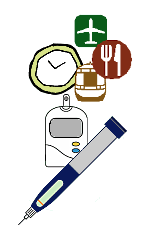いま、1型糖尿病は
2007年10月10日
| 27 Meals While in Other Countries and Insulin Dosage |

As an example, if you are in other countries (e.g. the U.S. or Europe) and determine insulin dosage assuming that the size or volume of meals you eat there is the same as that in Japan, you could often develop hypoglycemia (and hyperglycemia also).
"When I am in Japan, injecting this much insulin for this much meal works fine. But why doesn't it work in the U.S.?" You may wonder if your guess does not work anymore and may lose confidence you have gained from your experience.
That is because pre-meal regular or short-acting insulin dosage is most largely influenced by the amount of carbohydrate in a meal, Thus, it is important to think with a focus on how much carbohydrate you are going to take.
Reduce pre-meal regular or short-acting insulin
To be more specific, when you are in the U.S., for example, you need to reduce pre-meal regular or short-acting insulin dosage. If you inject the same dosage as that you inject in Japan, you are more likely to develop hypoglycemia even after two hours after a meal.
One of my patients has told me that reducing pre-meal insulin (regular or short-acting) to about two-thirds of the dosage he usually injects in Japan was just right.
First, it will be a good idea to inject less pre-meal insulin (regular or short-acting) than what you inject in Japan.
Increase long-acting soluble or intermediate-acting insulin?
When you reduce pre-meal insulin (regular or short-acting) dosage, you may need to increase the amount of base insulin (long-acting soluble or intermediate). The amount can be adjusted by monitoring blood glucose level of the following morning.
What about those on two-time mixed insulin?
Those of you who inject mixed insulin twice a day may need to measure blood glucose at bedtime when you reduce pre-dinner insulin dosage. And the dosage can be adjusted accordingly.
However, I would recommend you ask your doctor before traveling overseas how to adjust your dosage based on a type of mixed insulin you are using. In any case, you need to change the dosage back once you return to Japan.
Needless to say, Japanese are agricultural people as well as Thai and Vietnamese who all live on rice. Therefore, when you go to Thailand or Vietnam, you do not need to change your insulin dosage.
I had though that Chinese diet was that of agricultural people. However, having visited Beijing, it seems that rice is not their staple food. Their food culture is somewhat different. They use meat and oil a lot in their diet. Those living in Beijing may be descendants of equestrian people.
I have felt once again that it is important to know more about our rice-based food culture that we are accustomed to in order to determine appropriate insulin dosage when going overseas.
©2007 Yasuko Uchigata
海外での食事とインスリン注射量

その例として、海外(たとえば欧米)で、「日本で食べている食事量とボリュームが同じだ」と考えてインスリン注射量を決めていると、低血糖になることがよくあります(もちろん高血糖になることも)。
日本では「これくらいの食事量ならこれくらいのインスリン注射量」でうまくいっていたのに、どうしてアメリカの食事ではうまくいかないのだろう、となります。自分のこれまでの勘が働かなくなったのではないかと、これまでの自信が揺らいだりもしたりします。
なぜなら、食前の速効型または超速効型インスリンの注射量は、食物中の炭水化物の量が一番大きく影響します。炭水化物をどの程度摂取するのか、ここに重点をおいて考えましょう。
食前の速効型または超速効型を減らす
具体的には、アメリカにいって向こうの食事をするとなると、速効型または超速効型インスリンを日本の時の量より減らさないといけなくなります。日本にいたときと同じ量を注射すると食後2時間くらいでも、低血糖になりやすくなります。
ある方は、日本での食前インスリン(速効型または超速効型)の量を2/3くらいにするとちょうどよかったとおっしゃっていました。
まずは、食前インスリン(速効型または超速効型)の量をいつもの量より減らして、やってみるのがいいでしょう。
持効型溶解または中間型を増やす?
食前インスリン(速効型または超速効型)の注射量が減った分、ベースのインスリン量(持効型溶解または中間型)を増加することになるかもしれません。これは翌朝の血糖をみて、調節できますね。
混合型製剤2回打ちの方は?
混合型製剤の2回注射している方は、夕食前のインスリン量を減らすことになると、一度は寝る前の血糖測定も必要になるかもしれません。そして、調節していきます。
ただ、混合型製剤2回注射の方は、使っている混合型製剤にあった調節のやり方を海外にでかける前に先生に聞いておきましょう。
さて、いずれの場合も、帰国したらまた、もとに戻す必要があります。
我々日本人はもちろん農耕民族です。タイもベトナムも同じ農耕民族です。お米が主食です。タイやベトナムに出かけるときは、日本と同じでよい、といえますね。
中国も同じ農耕民族の食事かなと思っていたのですが、北京に出掛けてみて思うのですが、お米が主食であるとはいえないように思いました。食文化がどうもすこし違うように思いました。肉や油を多く使いますね。北京に住んでいる人は、騎馬民族の末裔でしょうか。
日頃親しんでいる日本のお米食文化について知っておくことも、海外へ出掛けたときにインスリン注射量をきめるためにも必要になるのだと痛感する次第です。
※ヘモグロビンA1c(HbA1c)等の表記は記事の公開時期の値を表示しています。
Copyright ©1996-2024 soshinsha. 掲載記事・図表の無断転用を禁じます。
治療や療養についてかかりつけの医師や医療スタッフにご相談ください。

 医療・健康情報グループ検索
医療・健康情報グループ検索